Crossing back into Chile - The Salar de Uyuni and the South West Circuit
An amazing 48 hour journey of incredible diverse landscapes, surreal scenery and enough altitude to make even the most acclimatizated Andean camelid gasp for breath ! The last 2 days have perhaps been THE highlight so far...
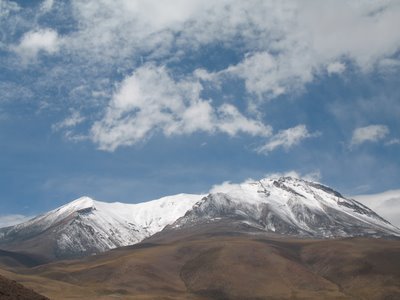
I met a few Brits in Potosi who wanted to do the same sort of tour as me, ending in San Pedro de Atacama, Chile and we agreed to meet up in Uyuni. The four of us set off on a 4WD tour with our quiet but reliable Bolivian driver and cook as our guide and the adventure began. The tour started off with a quick visit to the train graveyard. The town used to be an important rail hub for much of the mined metal making its way south, and the lines are still running for travellers crossing between Boliva, Chile and Argentina and journeys north to the capital. The rusted hulks we saw, were the remains of what was once a very lucrative trade.

It wasn´t much of a drive until we hit the vast salt plain itself (its the world´s largest), and it was every bit as impressive as I expected it to be. Villagers nearby have made a living out of "mining" the salt, in practice you don´t need to dig ! The modest sized piles of salt have a sort of geometrical perfection and the sun reflects brightly off the almost icey salt to create quite an effect. Striking out for the centre, we were soon engulfed in a desert of translucent white. Wow !

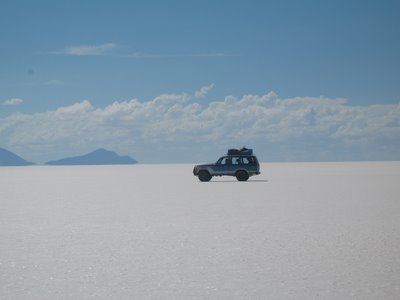
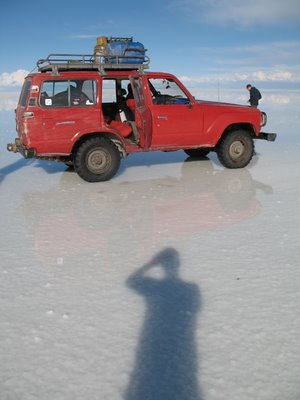
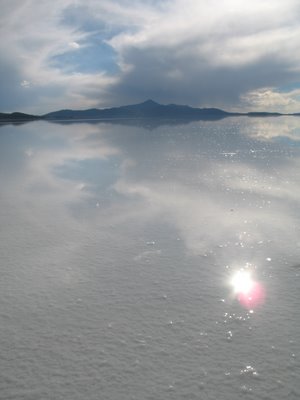
80km later we arrived at the rather surreal, isla de pescadores, a rocky island, where cacti rule the landscape and visacachas (a latin american rabbit) remain stranded amongst the rocks, isolated from the rest of the altiplano ecosystem. Our driver knocked up a quick and tasty lunch and were off again heading south now towards the lower part of the giant plain, where the water collects to create even more bizarre illusions. We drove onto a land bridge which connected us with the mainland again and the sun began to set as we arrived at the Salt Hotel. I had sort of imagined an igloo type structure but it looked more like a solid brick building. If you have never stayed a night in a salt hotel at 3600m then you have definitely missed out ! It was a strange end to an unusually brilliant day.
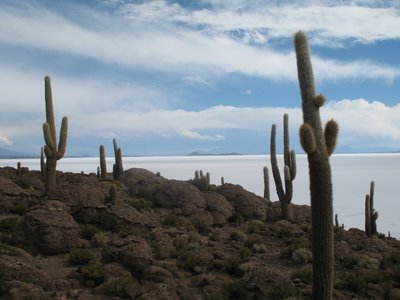

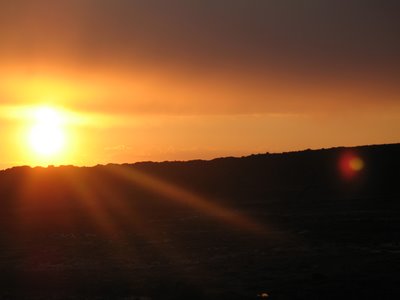
After a reasonably good nights sleep, we continued southwards paralleling the Chilean border, past slowly changing scenery and up a gradual dirt pass towards the snow-capped volcanos ahead of us. At the small broken village of San Juan, we bought some drinks and the driver got some coca leaves to chew for the journey and he proceeded to munch quietly away the entire afternoon. We slowly ascended to around the 4000m mark, the scenery constantly changing in colour and form, and the weather began to close in around us creating a small blizzard as we reached the first flamingo-filled salt lake. Its amazing to see these brightly coloured birds here - three of the five types of flamingo breed at these mineral rich altiplano lakes: the Chilean, Andean and James flamingos. As if on cue, the sun reappeared, warming things up to a pleasant 20C, clearing the clouds to reveal the giant volcanos now towering a mile above us. While we were being awed by it all, lunch appeared and a pair of mountain foxes hung in the background stealing pieces of meat when they could.
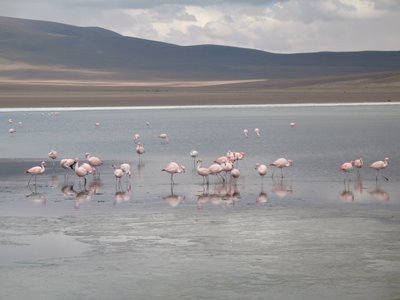
After lunch, we climbed steadily higher and higher, past more salt-rimmed flamingo containing lakes and past small heards of the beautiful vicuña. Approaching the 4500m highpoint of the day, the remaining hardy grasses of the high plain disappeared - we were now crossing a brown dirt desert and it began to snow gently, the sun still shining through the flakes.
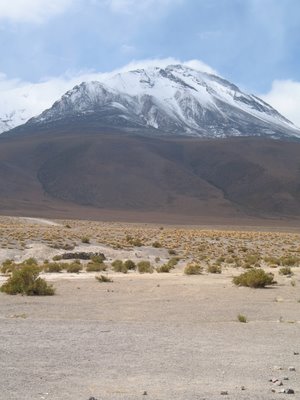
Just when you thought things couldn´t get any more odd, we arrived at the Arbol de Piedra, a selection of eroded rock formations. The sun had reappeared once more but the day was fading fast. How may seasons had we seen now ? Four or maybe even five perhaps. Yet again the weather changed and we reached the largest flamingo-breeding lake, Laguna Colorado, in fading light and increasing cloud. The red coloured water was a sort of petrol purple between white strips of mineral rich rock, which from a distance appeared like ice. The red colour comes from the algae, which concentrate minerals like borax and gypsum along with calcium and sodium salts. Here the thousands of flamingos were communicating to each other in large teams - a truly amazing sight indeed.
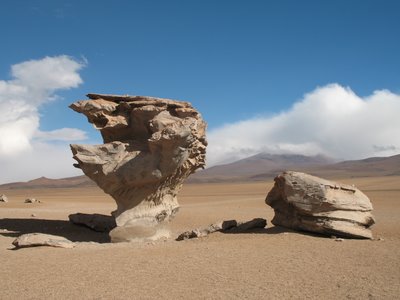
Shortly afterwards we reached the rather more basic accomodation for the night at around 4250m. Its amazing how the people survive at this altitude. As were all to find out, it was to prove a rough, cold, old night as the village was engulfed in a vicous snowstorm. Inside we kept warm drinking red wine and feasting on pasta napolitana. None of us got much sleep, the combination of vino tinto and altitude perhaps effecting me the worst and I only got snapshots of sleep. The new day dawned with us all feeling a little edgy, after a long restless night, but glad to see the dawn. After breakfast, all our spirits had improved enormously and we set off for the final leg of the journey.
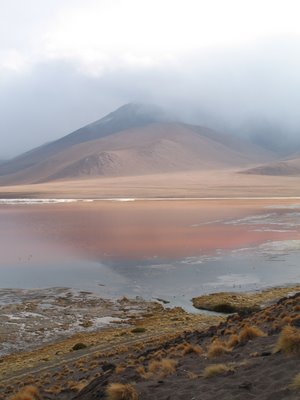
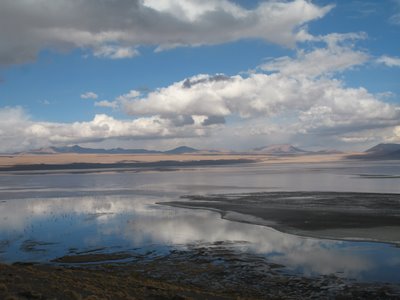
The storm had left a thick frost and within an hour of our continual gradual ascent, we were surrounded by blankets of snow, covering the rolling hills around us. This was truly a most unexpected surprise. By the time we had reached the geyser field, el sol de manaña, at 4800m, we were amongst probably the most impressive winter scenery I have ever seen. As the sun heated the day up, the fumaroles were really coming to life. Steaming giant kettles and cauldrons created a minefield of boiling holes and a mist of toxic sulphurous gases.
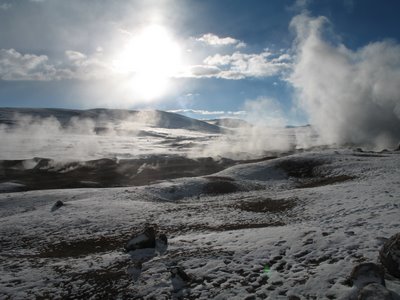
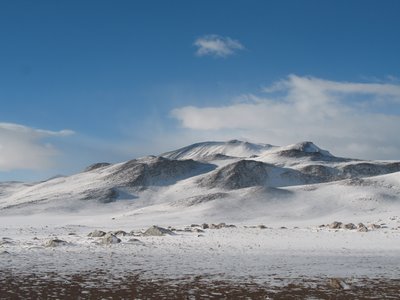
We cleared 5000m, the altitude sickness now strangely a faded memory, and arrived at our final stop, Laguna Verde, surrounded by layers of dark clouds. Its the more poisonous of the giant salt lakes, with rich deposits of sulphour, lead, arsenic and other heavy metals. With no sun, our supposed blue-green lake was more of a dark, oily, military green. No flamingos dared drink from this soup, the mud at the edge is a thick browny-white paint which almost ruined my trainers.
An amazing 48 hour journey of incredible diverse landscapes, surreal scenery and enough altitude to make even the most acclimatizated Andean camelid gasp for breath ! The last 2 days have perhaps been THE highlight so far...

I met a few Brits in Potosi who wanted to do the same sort of tour as me, ending in San Pedro de Atacama, Chile and we agreed to meet up in Uyuni. The four of us set off on a 4WD tour with our quiet but reliable Bolivian driver and cook as our guide and the adventure began. The tour started off with a quick visit to the train graveyard. The town used to be an important rail hub for much of the mined metal making its way south, and the lines are still running for travellers crossing between Boliva, Chile and Argentina and journeys north to the capital. The rusted hulks we saw, were the remains of what was once a very lucrative trade.

It wasn´t much of a drive until we hit the vast salt plain itself (its the world´s largest), and it was every bit as impressive as I expected it to be. Villagers nearby have made a living out of "mining" the salt, in practice you don´t need to dig ! The modest sized piles of salt have a sort of geometrical perfection and the sun reflects brightly off the almost icey salt to create quite an effect. Striking out for the centre, we were soon engulfed in a desert of translucent white. Wow !




80km later we arrived at the rather surreal, isla de pescadores, a rocky island, where cacti rule the landscape and visacachas (a latin american rabbit) remain stranded amongst the rocks, isolated from the rest of the altiplano ecosystem. Our driver knocked up a quick and tasty lunch and were off again heading south now towards the lower part of the giant plain, where the water collects to create even more bizarre illusions. We drove onto a land bridge which connected us with the mainland again and the sun began to set as we arrived at the Salt Hotel. I had sort of imagined an igloo type structure but it looked more like a solid brick building. If you have never stayed a night in a salt hotel at 3600m then you have definitely missed out ! It was a strange end to an unusually brilliant day.



After a reasonably good nights sleep, we continued southwards paralleling the Chilean border, past slowly changing scenery and up a gradual dirt pass towards the snow-capped volcanos ahead of us. At the small broken village of San Juan, we bought some drinks and the driver got some coca leaves to chew for the journey and he proceeded to munch quietly away the entire afternoon. We slowly ascended to around the 4000m mark, the scenery constantly changing in colour and form, and the weather began to close in around us creating a small blizzard as we reached the first flamingo-filled salt lake. Its amazing to see these brightly coloured birds here - three of the five types of flamingo breed at these mineral rich altiplano lakes: the Chilean, Andean and James flamingos. As if on cue, the sun reappeared, warming things up to a pleasant 20C, clearing the clouds to reveal the giant volcanos now towering a mile above us. While we were being awed by it all, lunch appeared and a pair of mountain foxes hung in the background stealing pieces of meat when they could.

After lunch, we climbed steadily higher and higher, past more salt-rimmed flamingo containing lakes and past small heards of the beautiful vicuña. Approaching the 4500m highpoint of the day, the remaining hardy grasses of the high plain disappeared - we were now crossing a brown dirt desert and it began to snow gently, the sun still shining through the flakes.

Just when you thought things couldn´t get any more odd, we arrived at the Arbol de Piedra, a selection of eroded rock formations. The sun had reappeared once more but the day was fading fast. How may seasons had we seen now ? Four or maybe even five perhaps. Yet again the weather changed and we reached the largest flamingo-breeding lake, Laguna Colorado, in fading light and increasing cloud. The red coloured water was a sort of petrol purple between white strips of mineral rich rock, which from a distance appeared like ice. The red colour comes from the algae, which concentrate minerals like borax and gypsum along with calcium and sodium salts. Here the thousands of flamingos were communicating to each other in large teams - a truly amazing sight indeed.

Shortly afterwards we reached the rather more basic accomodation for the night at around 4250m. Its amazing how the people survive at this altitude. As were all to find out, it was to prove a rough, cold, old night as the village was engulfed in a vicous snowstorm. Inside we kept warm drinking red wine and feasting on pasta napolitana. None of us got much sleep, the combination of vino tinto and altitude perhaps effecting me the worst and I only got snapshots of sleep. The new day dawned with us all feeling a little edgy, after a long restless night, but glad to see the dawn. After breakfast, all our spirits had improved enormously and we set off for the final leg of the journey.


The storm had left a thick frost and within an hour of our continual gradual ascent, we were surrounded by blankets of snow, covering the rolling hills around us. This was truly a most unexpected surprise. By the time we had reached the geyser field, el sol de manaña, at 4800m, we were amongst probably the most impressive winter scenery I have ever seen. As the sun heated the day up, the fumaroles were really coming to life. Steaming giant kettles and cauldrons created a minefield of boiling holes and a mist of toxic sulphurous gases.


We cleared 5000m, the altitude sickness now strangely a faded memory, and arrived at our final stop, Laguna Verde, surrounded by layers of dark clouds. Its the more poisonous of the giant salt lakes, with rich deposits of sulphour, lead, arsenic and other heavy metals. With no sun, our supposed blue-green lake was more of a dark, oily, military green. No flamingos dared drink from this soup, the mud at the edge is a thick browny-white paint which almost ruined my trainers.
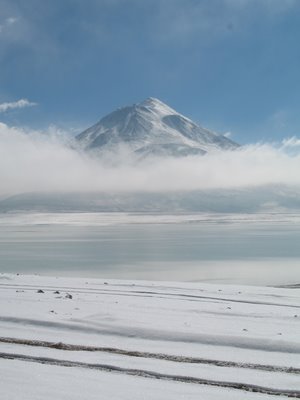
A very short drive onwards, took us to the giant 5960m, Volcan Licanbur at the Chilean border and we were processed quickly and efficiently into the much wealthier country. Soon, we were back on the first paved road I had seen for almost a week and dropped steeply 2500m down to San Pedro de Atacama. The Atacama desert is one of the worlds driest, barely receiving any rainfall. Basic plant life soon reappeared in the richer red soil as we passed Chile´s largest salt lake, a multicoloured affair which also supports flamingos. It was only 45 minutes from the border to the town, a funky gringo packed desert oasis, where the temperature was sitting pleasantly in the high 20s. Despite having the time our lives, we all felt much better after a Mexican lunch, shower and a relaxing afternoon strolling the quiet streets.
I can´t emphasis how highly I recommend this trip if you are ever in the neighbourhood !
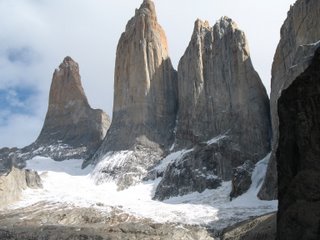

0 Comments:
Post a Comment
<< Home